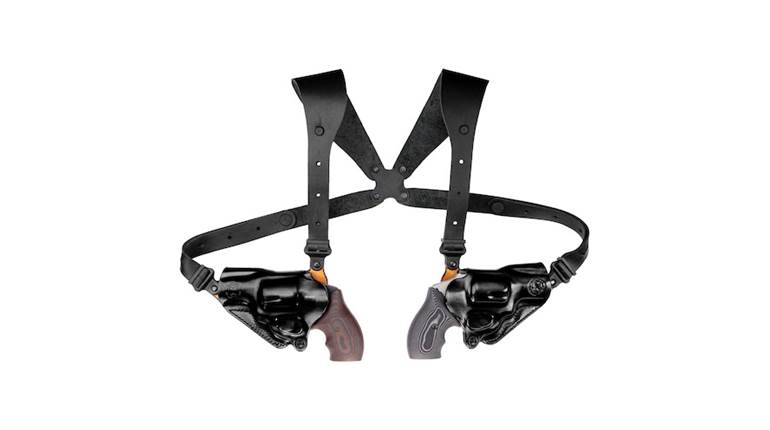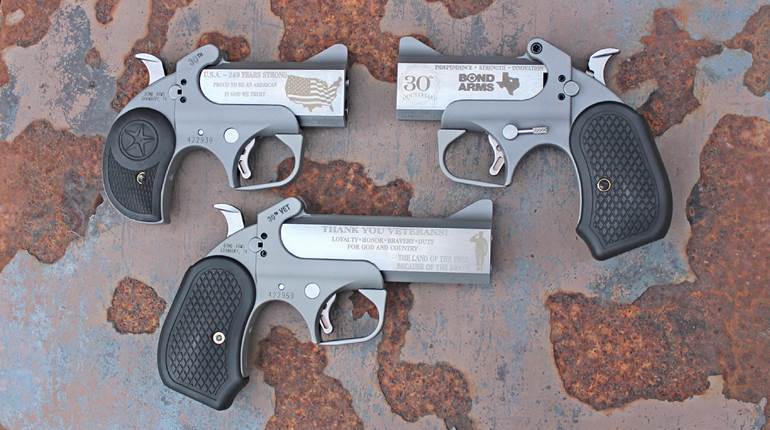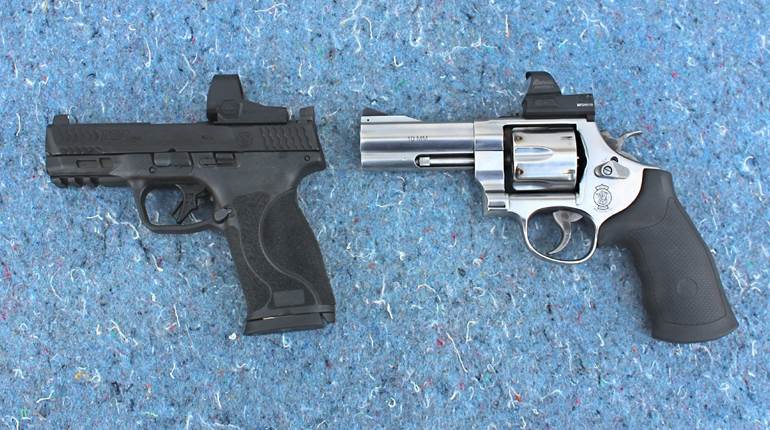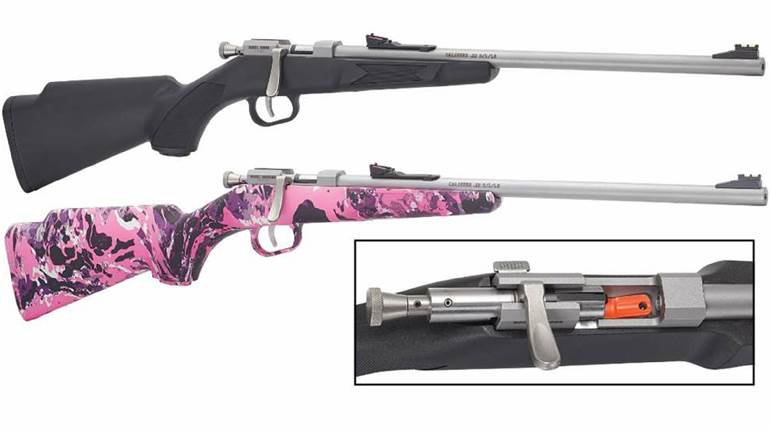
1/16/2013
Since 1971, North American Arms (NAA) of Provo, Utah, has been providing gun owners with one of the smallest defensive revolvers available. These ultra-compact, single-action wheelguns are available with a variety of barrel lengths, sight systems and grip sizes, but most of them have one feature in common: The cylinder pin is pulled free of the frame so the cylinder can be completely removed from the revolver for reloading. While this design feature has done little to hamper the popularity of these diminutive rimfire revolvers, some customers have been asking for a Mini with a swing-out cylinder that remains attached to the frame. As has often been the case with customer requests to North American Arms, the wish has been granted.
The all-stainless-steel Sidewinder Mini revolver is built on NAA's .22 Mag. frame and features a 1 3/8-inch barrel, a bead front sight and a cylinder shroud. The shroud has been marked on the left side with two notches. These provide a visual demarcation to help the shooter align the cylinder properly when setting the hammer into one of the safety notches between the chambers. Below the barrel, the frame has been extended and hollowed out to make room for a crane arm to support the swing-out cylinder. The removable cylinder pin has been replaced by a spring-loaded extractor rod, with an extractor star to press out spent cartridge casings. It's important to note here that this Mini is a hybrid of sorts. Although the cylinder swings out and shells are extracted much like a modern double-action revolver, the Sidewinder has a single-action trigger like other Minis from North American Arms. The hammer needs to be fully cocked before each shot is fired.
The laminated Rosewood grip panels are new as well. Previous grip panels were beveled at the edges with a flat grip surface. The Sidewinder grips have a fully rounded contour that gives the birds head grip more of a teardrop shape. This grip configuration is a little thicker near the base of the grip, but the curvature is more comfortable to shoot with, and this grip is likely to find its way onto other revolvers in the future. Like many other Minis, the Sidewinder can be ordered with an additional cylinder for use with .22 Long Rifle cartridges. The cylinders can be quickly exchanged by removing the crane arm screw located at the front of the frame below the barrel. The additional features of the Sidewinder have only increased the weight of the revolver by a fraction of an ounce in comparison to the standard .22 Mag. Minis.
On the shooting range, the Sidewinder handled itself like other Minis I've tested over the years. The fit and finish is superb. The crisp single-action trigger only required 1/8 inch of travel with 4 pounds, 7 ounces of pressure to reliably release the hammer. This revolver successfully fired and ejected a wide variety of .22 Mag. and .22 Long Rifle loads. Some of the spent cases of the hopped-up .22 Mag. rounds, and a few of the cheap .22 LR rounds, were tough to eject. This is due to the tight tolerances North American Arms adheres to in building its guns. As with any other rimfire gun, it's a good idea to test a particular cartridge for proper function before purchasing large quantities of ammunition.
The process of loading the Sidewinder is not quite like any other modern revolver currently in production. Start by pointing the revolver in a safe direction, and placing the hammer in the half-cocked position. Pinch the knurled ejector rod head between the thumb and index fingers of the support hand and pull it forward toward the barrel’s muzzle. While holding the ejector rod in this position, swing the cylinder out to the right side of the frame. Work the ejector rod to press out any spent cases from the cylinder, and load fresh cartridges into the cylinder. You'll need to rotate the cylinder to load the chamber closest to the frame because the grip blocks the chamber mouth. In order for the cylinder to seat completely back into the frame, it's necessary to apply pressure to the knurled ejector rod head with the tip of the index finger of the support hand, while pressing the cylinder home with the middle and ring finger. It's not an excessive amount of pressure, but some is needed to get the job done. Pull the hammer back to the fully cocked position to fire the Sidewinder, or rotate the cylinder to set the hammer into a safety notch to prepare the revolver for concealed carry.
Does the loading process sound a bit complicated? While it does require a few more steps than a typical double-action revolver, reloading is more quickly accomplished than when using a Mini with a pop-out cylinder. It does require a bit of getting used to, much like the Mini concept itself, but with practice comes familiarity, then ease. An added benefit of the Sidewinder’s attached cylinder is that it eliminates the opportunity of hunting for a dropped cylinder pin on a grassy plain or shooting range floor.
Bench resting such a small revolver to test for accuracy may seem like an extraneous exercise, since the Mini is the definition of a close-range defensive handgun. But what becomes clear with bench testing, even at close range, is that Minis are capable of placing solid center-of-mass strikes if the shooter is willing to master the ergonomics of the tiny trigger stud and diminutive grip. At 7 yards, this pocket pistol turned in its best .22 Mag. group average of 2.75 inches using the new Winchester PDX1 jacketed hollow points. If you choose to go heeled with the Sidewinder's .22 Long Rifle cylinder installed, be sure to load it with high-quality ammunition. CCI's Stinger 32-grain copper plated hollow points produced the best group average of 3 inches among the .22 Long Rifle cartridges tested.
For those looking for a tiny, deep-concealment handgun, the Sidewinder demonstrated the same levels of craftsmanship and reliability as the pop-out cylinder versions North American Arms has provided for over three decades. For shooters who like Minis, the swing-out cylinder does provide a more comfortable reloading process. For the rabid fans and collectors of Minis, you can look forward to adding yet another unique Mini revolver to your collection that’s also fun to shoot.
Manufacturer: North American Arms; northamericanarms.com
Model: Sidewinder
Action: Single Action
Caliber: .22 Magnum (.22 LR Conversion Available)
Finish: Stainless Steel
Grips: Laminated Rosewood
Sights: Bead Front Fixed
Barrel Length: 1 3/8”
Overall Length: 5”
Height: 2 7/8”
Width: 1 1/16”
Weight: 6.7 ozs.
Capacity: 5 Rounds
Twist: 1:12” RH
Rifle Grooves: 8
Accessories: Lockable Hard Case, Lock, and Owner’s Manual
Suggested Retail Price: $349 Single Cylinder, $428 Dual Cylinder





































